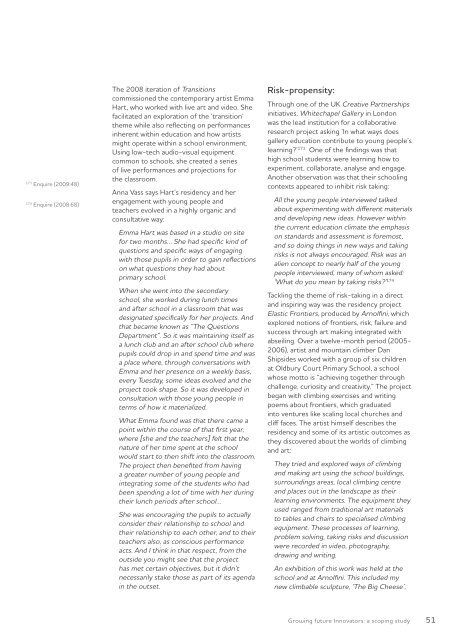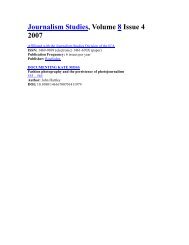GrowinG Future innovators - ARC Centre of Excellence for Creative ...
GrowinG Future innovators - ARC Centre of Excellence for Creative ...
GrowinG Future innovators - ARC Centre of Excellence for Creative ...
Create successful ePaper yourself
Turn your PDF publications into a flip-book with our unique Google optimized e-Paper software.
173 Enquire (2009:48)<br />
174 Enquire (2008:68)<br />
The 2008 iteration <strong>of</strong> Transitions<br />
commissioned the contemporary artist Emma<br />
Hart, who worked with live art and video. She<br />
facilitated an exploration <strong>of</strong> the ‘transition’<br />
theme while also reflecting on per<strong>for</strong>mances<br />
inherent within education and how artists<br />
might operate within a school environment.<br />
Using low-tech audio-visual equipment<br />
common to schools, she created a series<br />
<strong>of</strong> live per<strong>for</strong>mances and projections <strong>for</strong><br />
the classroom.<br />
Anna Vass says Hart’s residency and her<br />
engagement with young people and<br />
teachers evolved in a highly organic and<br />
consultative way:<br />
Emma Hart was based in a studio on site<br />
<strong>for</strong> two months… She had specific kind <strong>of</strong><br />
questions and specific ways <strong>of</strong> engaging<br />
with those pupils in order to gain reflections<br />
on what questions they had about<br />
primary school.<br />
When she went into the secondary<br />
school, she worked during lunch times<br />
and after school in a classroom that was<br />
designated specifically <strong>for</strong> her projects. And<br />
that became known as “The Questions<br />
Department”. So it was maintaining itself as<br />
a lunch club and an after school club where<br />
pupils could drop in and spend time and was<br />
a place where, through conversations with<br />
Emma and her presence on a weekly basis,<br />
every Tuesday, some ideas evolved and the<br />
project took shape. So it was developed in<br />
consultation with those young people in<br />
terms <strong>of</strong> how it materialized.<br />
What Emma found was that there came a<br />
point within the course <strong>of</strong> that first year,<br />
where [she and the teachers] felt that the<br />
nature <strong>of</strong> her time spent at the school<br />
would start to then shift into the classroom.<br />
The project then benefited from having<br />
a greater number <strong>of</strong> young people and<br />
integrating some <strong>of</strong> the students who had<br />
been spending a lot <strong>of</strong> time with her during<br />
their lunch periods after school…<br />
She was encouraging the pupils to actually<br />
consider their relationship to school and<br />
their relationship to each other, and to their<br />
teachers also, as conscious per<strong>for</strong>mance<br />
acts. And I think in that respect, from the<br />
outside you might see that the project<br />
has met certain objectives, but it didn’t<br />
necessarily stake those as part <strong>of</strong> its agenda<br />
in the outset.<br />
Risk-propensity:<br />
Through one <strong>of</strong> the UK <strong>Creative</strong> Partnerships<br />
initiatives, Whitechapel Gallery in London<br />
was the lead institution <strong>for</strong> a collaborative<br />
research project asking ‘In what ways does<br />
gallery education contribute to young people’s<br />
learning?’ 173 One <strong>of</strong> the findings was that<br />
high school students were learning how to<br />
experiment, collaborate, analyse and engage.<br />
Another observation was that their schooling<br />
contexts appeared to inhibit risk taking:<br />
All the young people interviewed talked<br />
about experimenting with different materials<br />
and developing new ideas. However within<br />
the current education climate the emphasis<br />
on standards and assessment is <strong>for</strong>emost,<br />
and so doing things in new ways and taking<br />
risks is not always encouraged. Risk was an<br />
alien concept to nearly half <strong>of</strong> the young<br />
people interviewed, many <strong>of</strong> whom asked:<br />
‘What do you mean by taking risks?’ 174<br />
Tackling the theme <strong>of</strong> risk-taking in a direct<br />
and inspiring way was the residency project<br />
Elastic Frontiers, produced by Arnolfini, which<br />
explored notions <strong>of</strong> frontiers, risk, failure and<br />
success through art making integrated with<br />
abseiling. Over a twelve-month period (2005-<br />
2006), artist and mountain climber Dan<br />
Shipsides worked with a group <strong>of</strong> six children<br />
at Oldbury Court Primary School, a school<br />
whose motto is “achieving together through<br />
challenge, curiosity and creativity.” The project<br />
began with climbing exercises and writing<br />
poems about frontiers, which graduated<br />
into ventures like scaling local churches and<br />
cliff faces. The artist himself describes the<br />
residency and some <strong>of</strong> its artistic outcomes as<br />
they discovered about the worlds <strong>of</strong> climbing<br />
and art:<br />
They tried and explored ways <strong>of</strong> climbing<br />
and making art using the school buildings,<br />
surroundings areas, local climbing centre<br />
and places out in the landscape as their<br />
learning environments. The equipment they<br />
used ranged from traditional art materials<br />
to tables and chairs to specialised climbing<br />
equipment. These processes <strong>of</strong> learning,<br />
problem solving, taking risks and discussion<br />
were recorded in video, photography,<br />
drawing and writing.<br />
An exhibition <strong>of</strong> this work was held at the<br />
school and at Arnolfini. This included my<br />
new climbable sculpture, ‘The Big Cheese’,<br />
Growing future Innovators: a scoping study 51




![Plebiscite (Riegert chapter) revised FINAL [Feb 14].pdf](https://img.yumpu.com/8710373/1/190x245/plebiscite-riegert-chapter-revised-final-feb-14pdf.jpg?quality=85)